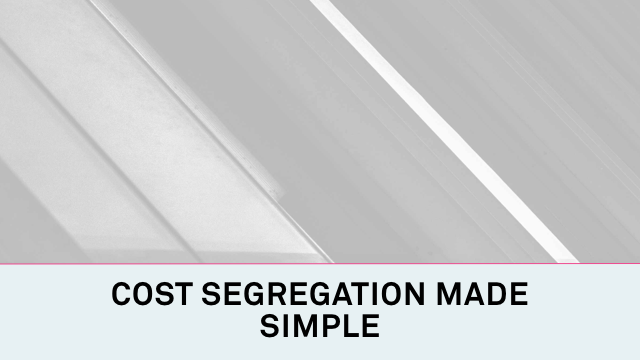Table of Contents
Many people invest in multifamily real estate as a way of both diversifying their portfolios and generating stable, passive income.
But what if we were to tell you there’s another benefit to owning multifamily real estate? A benefit that is often overlooked, but potentially worth even more than the cash flow investors can expect to earn.
It may sound too good to be true, but it’s not.
One of the primary benefits of investing in an apartment building is its tax saving benefits. Specifically, investors can utilize “depreciation” to their advantage. Depreciation is a deduction that investors can take each year. It is to account for a property’s physical wear and tear and eventual obsolescence.
Typically, apartment buildings are depreciated over a 27.5 year period. This is what the IRS has deemed as the “useful life” of a multifamily property.
An inexperienced investor might simply tax advantage of straight line deprecation. They can then claim 1/27.5 of the value of that depreciation each year.
Many people invest in multifamily real estate as
a way of both diversifying their portfolios
and generating stable, passive income.
More sophisticated investors know to use a cost segregation study to accelerate depreciation. In which effectively front loads depreciation to offset earnings during the first few years of ownership.
In this article, we offer a complete guide to cost segregation studies for multifamily real estate.
What is a Cost Segregation Study?
A cost segregation study is a necessary precursor for any multifamily investor looking to accelerate their depreciation write offs.

A licensed engineer typically conducts most cost segregation studies. That engineer will visit a property, spreadsheet in hand, and will walk through the interior and exterior of a property to identify each of its constituent parts (e.g., roof, electrical wiring, carpet, appliances, driveways and more).
Assigning a useful life to each of these building components is necessary. In which the IRS then allows the owner to depreciate accordingly.
Therefore, rather than depreciating a property by 1/27.5 each year. They depreciate it based on the remaining value of those building components. These lifespans may range from 1 to 15 years, depending on the building component.
For example, a carpet may depreciate over five years whereas a newer roof might depreciate over 15 years. In any event, most building components will depreciate faster than 27.5 years as they would otherwise if using straight-line depreciation.
What does a Cost Segregation Study Entail?
While there is no prescribed qualifications for who conducts a cost segregation study. The IRS suggests that it be someone who has knowledge of both the construction process and tax laws involving property classifications for depreciation purposes. Essentially, this means that most cost segregation studies are performed by a licensed engineer.
A quality cost segregation study will include a thorough review of all relevant property information. This is including but not limited to building cost and market data, building plans, and lease agreements. The preparer will also look at detailed site features, such as its location, topography, and site conditions.
The engineer will also conduct a site visit in which they examine all building components. This portion of the analysis can be extremely detailed. For instance, they might assign one value to a building door and another value to the lock used on that door.
New construction
For new construction, the cost of both building and personal property is generally easy to estimate. Estimating the costs for older properties can be more challenging. This is why the surveyor will want to document how they arrived at the pricing for those building components. A final cost segregation study usually includes detailed notes and photographic evidence.
Note: land and certain land improvements (e.g., the costs associated with grading a property for future development) are not considered depreciable costs. Only qualifying land improvements, buildings, structural building components or systems, and non-residential real property can be depreciated.
In other words, if someone purchases an apartment building for $1 million and the land value for that property is $300,000, then only $700,000 worth of assets are likely to be eligible for depreciation.
In some cases, a cost segregation study will include interviews with various parties. This could include interviews with contractors and subcontractors, building owners, and property managers. These interviews help to add credibility to the depth and accuracy of a cost segregation study.
Taken together, the principal elements of a quality cost segregation report will therefore include:
Executive Summary
An Executive Summary that identifies who prepared the report, the date of the study, for whom the study was prepared, the subject property, and the property units classified as land, land improvements, building or personal property.
Narrative Report
A Narrative Report that provides a more detailed description of the apartment building. This will usually also indicate the types and sources of data used in the preparation of the study.
Schedule of Assets
A Schedule of Assets that clearly identifies the specific assets that can be depreciated.
Schedule of Direct and Indirect Costs
A Schedule of Direct and Indirect Costs associated with the project.
Schedule of Property Units and Costs
A Schedule of Property Units and Costs that are segregated into land, building property and personal property.
Engineering Methodology
The Engineering Methodology was used to determine the costs for each depreciable property unit. This will note whether the costs are actual or estimated.
Statement of Assumptions and Limiting Conditions
A Statement of Assumptions and Limiting Conditions that can be used to indicate the quality of the study.
Certification
A Certification by the licensed engineer who completed the study. This including their credentials and/or level of experience conducting these types of cost segregation studies.
Various Exhibits
Various Exhibits are usually included at the end of a cost segregation study. These exhibits provide backup and accounting to support the preparer’s analysis.
Learn more about what the IRS classifies as a “quality” cost segregation study.
How does a Cost Segregation Study Save Investors Money?
Most investors will discover that, on average, they can depreciate most apartment buildings within the first seven years of ownership.
Rather than depreciating 1/27.5 of a property every year by using straight line depreciation, investors can front load depreciation in the first few years of ownership.
One does not need to be the sole owner of an apartment building to enjoy the benefits of cost segregation.
Under changes made to the tax code under the Trump Administration. Investors can maximize their benefits through “bonus depreciation”. Under these new regulations, real estate investors can deduct 100% of a building value in the first year of ownership.
It used to be that bonus depreciation only applied to new equipment or new construction. Now it applies to existing assets as well. This creates a giant “paper loss” for investors that they can use to offset their taxable income.
Note: there is some people discussing reducing or eliminating bonus depreciation in the future, but for now, it remains available and provides a substantial advantage to real estate investors.
What this does, in practice, is it effectively puts more money back into investors’ pockets sooner than if they were utilizing straight line (or traditional accelerated) depreciation alone.
It is not uncommon for a cost segregation study to generate hundreds of thousands, even millions, of dollars in net present value savings for investors.
Someone who invested $250,000 into an apartment building might be able to use a cost segregation study to save $100,000 in taxes during the first year of property ownership. This is a staggering return on investment compared to the cash flow generated during that time alone.
Alternatives
Let’s say the property does not generate $100,000 in income that first year. An investor can do one of three things. First, they can use that “passive” loss to offset other passive income earned on their other investments.
If they have no other passive income to apply the depreciation to that year. The investor then can instead apply the depreciation retroactively to passive income earned in the years prior.
A third alternative is to save any remaining depreciation benefits, carrying it forward to apply to passive income earned the following tax year.
One does not need to be the sole owner of an apartment building to enjoy the benefits of cost segregation. Passive investors, including those who invest in a real estate syndicate or fund, will also benefit when a multifamily sponsor does a cost segregation study and passes these cost savings on to their limited partners. Come tax time, investors will report both their investment income and depreciation write offs on their K-1 form.
It may look like an investor is “losing” money on a real estate investment, when in fact they are just claiming a paper loss that. This boosts their total take home income.
Many investors will continue buying multifamily real estate just for the depreciation benefits. This allow some investors to pay little to no income taxes on an ongoing basis.
Conclusion
Real estate investors often talk about the tax benefits associated with the asset class. Those who are less familiar with depreciation and cost segregation have a hard time understanding what these benefits include, and more importantly, how much money this translates into in practice.
A cost segregation study is a highly effective
way for multifamily real estate investors
to maximize the value of their property
As shown in this guide, a cost segregation study is a highly effective way for multifamily real estate investors to maximize the value of their property. Taking these “paper losses” is one of the best ways to enhance the overall return on investment. Investors can use those savings to invest in future deals, which they can also depreciate. This creates a cycle where they continuously generate income that surpasses what they would earn from rental cash flow alone.
Do you have an interest in investing in multifamily real estate? Contact us today to learn more about how Smartland maximizes returns for its investors.
FAQ About Cost Segregation Studies for Multifamily Real Estate
Who should consider doing a cost segregation study?
Any multifamily real estate investor who purchases a newly constructed building, or who purchases a building that they then renovate and subsequently lease, will want to consider doing a cost segregation study.
How much does a cost segregation study cost?
A detailed cost segregation study will cost between $5,000 and $30,000 or more, depending on the size of the apartment building and its complexities. For example, a multi-building apartment complex will usually require a more detailed cost segregation system, especially if each building runs on its own systems. A single-building, garden-style apartment building might be much simpler for an engineer to review.
How long does a cost segregation study take?
Cost segregation will generally take 30-60 days to complete, but again, this depends on the size and scale of the apartment building being evaluated. If an owner can pull together relevant property data, building records, lease records, etc. in advance, this can help streamline the process for the examiner conducting the study.
When is the best time to do a cost segregation study?
Most owners and investors will want to do a cost segregation study shortly after purchasing the property or placing it “in service”. This might be in Year 1 of ownership if acquiring an existing assetQuestion Mark, but might not be until Year 3 if the project required ground-up construction. The sooner someone does a cost segregation study, the more likely they are to maximize the benefits of that depreciation (especially given the risk of bonus depreciation phasing out in the years to come).
Will a cost segregation study increase the likelihood of being audited?
No. If conducted by a licensed professional who specializes in cost segregation (vs. your CPA, for example), there is no enhanced risk of being audited. Experienced cost segregation professionals will provide a detailed report that is defensible, even in the event of an IRS audit.




